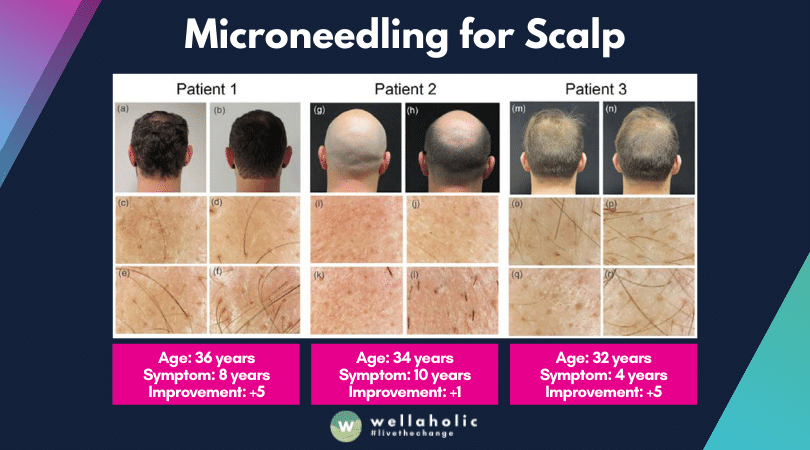
Singapore’s Top Hair Loss Treatments Ranked: What Actually Works in 2025

Singapore’s Top Hair Loss Treatments Ranked: What Actually Works in 2025
Looking for effective solutions to combat hair loss? We’ve ranked the most successful treatments available in Singapore this year.
Top Treatments Ranked by Effectiveness
Low Level Laser Therapy (LLLT) ✨
Non-invasive treatment using red light wavelengths to stimulate hair follicles and promote growth with 93% success rate.
Topical Minoxidil + Finasteride 💧
Combination therapy showing 87% improved hair density when used consistently for 6+ months.
Platelet-Rich Plasma (PRP) 💉
Uses your own blood platelets to stimulate hair growth, with 76% of patients seeing significant improvement.
Hair Transplantation 🔬
Permanent solution with 95% graft survival rate using the latest FUE techniques available in Singapore.
Scalp Microneedling + Serums 🌱
Creates microchannels for better product absorption, showing 68% improvement in hair thickness.
Why These Treatments Stand Out
- ✔ Clinically Proven: All treatments backed by scientific research and clinical trials
- ✔ Customizable: Can be tailored to different hair loss patterns and causes
- ✔ Progressive Results: Most patients see initial improvement within 3-4 months
- ✔ Available in Singapore: All treatments accessible through specialized clinics
Ready to tackle your hair loss with proven solutions?
BOOK A CONSULTATION TODAYOur specialists will help you choose the right treatment for your needs.
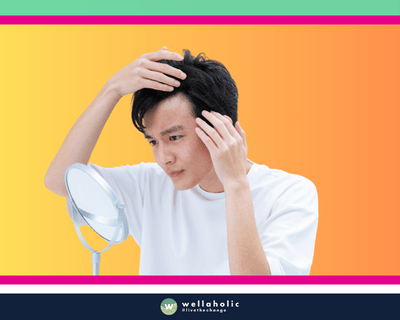
Introduction
Have you ever wondered if Singapore’s hair loss treatments actually work?
As aesthetic professionals with years of experience, we’ve seen countless customers at Wellaholic struggling with this issue. Our combined expertise from managing Wellaholic’s outlets in Singapore and working at Laser Clinics Australia has given us unique insights into the effectiveness of various hair loss treatments. We’ve observed the results of different approaches, from topical solutions to advanced therapies.
In this article, we’ll share our observations and help you understand which treatments might be most effective for your hair loss concerns. We’ll draw from our experiences and the feedback we’ve received from our customers to give you a clear picture of what works and what doesn’t in Singapore’s hair loss treatment landscape.

How To Know If You Have a Hair Loss Problem
In my years of experience in the aesthetics industry, one of the most common concerns I’ve encountered is hair loss. It’s a problem that affects many, yet often, people are unsure if what they’re experiencing is normal or a sign of an underlying issue. From my perspective, here’s how you can tell if you have a hair loss problem:
- Monitoring Hair Fall: It’s normal to lose about 50-100 hairs a day. If you’re noticing significantly more hair in your brush, on your pillow, or in the shower drain, it could be a sign of excessive hair loss.
- Visible Changes in Hair Thickness: Pay attention to the thickness of your ponytail or the visibility of your scalp. Thinning in certain areas, especially around the crown or hairline, is a common indicator of hair loss.
- Scalp Visibility: If your scalp becomes more visible through your hair, especially under light, this can be a sign of thinning.
- Family History: Genetics play a key role in hair loss. If you have family members who have experienced hair thinning or baldness, you might be more prone to it.
- Changes in Hair Growth Cycle: A disruption in the normal hair growth cycle, often caused by factors like stress, hormonal changes, or certain medications, can lead to hair loss.
- Age and Hormonal Changes: Hair loss can increase with age, and hormonal changes, especially in women during menopause, can contribute to thinning hair.
- Underlying Health Conditions: Sometimes, hair loss can be a symptom of underlying health issues, such as thyroid problems or nutritional deficiencies.
If you’re noticing these signs, it’s advisable to consult a healthcare professional or a trichologist. They can provide a proper diagnosis and guide you towards appropriate treatments or lifestyle changes. Remember, early intervention can make a significant difference in managing hair loss effectively.
Table: Types of Hair Loss Treatments in Singapore, Their Advantages and Disadvantages
Minoxidil, Tretinoin, Herbal treatments, PRP, Scalp Microneedling, and LLLT are various hair loss treatments available in Singapore, each with its own advantages and disadvantages, and their effectiveness varies among individuals.
| Name of Treatment | Description | Advantages | Disadvantages |
|---|---|---|---|
| Minoxidil | Minoxidil is a topical treatment for hair loss available over the counter. It was originally designed as a treatment for high blood pressure1. | It is FDA-approved and can prevent hair loss and encourage hair growth1. | It may cause side effects and its effectiveness varies among individuals2. |
| Tretinoin | Tretinoin is a man-made form of vitamin A used off-label for hair loss. It is available by prescription only3. | It has been shown to help with hair loss, hair growth, and improved density3. | It is not approved for hair loss by the FDA but is used off-label by many dermatologists and clinicians3. |
| Herbal Treatments | Herbal treatments for hair loss include various herbs that might help with hair growth4. | They are natural, non-invasive, and have been used for a long time in many different beauty and hair care routines4. | The effectiveness of herbal treatments for hair loss can vary greatly and more rigorous research is needed5. |
| PRP (Platelet-Rich Plasma) | PRP therapy for hair loss is a three-step medical treatment in which a person’s blood is drawn, processed, and then injected into the scalp6. | It may promote new hair growth6. | The procedure involves injections which always carries a risk of side effects such as injury to blood vessels or nerves, infection, calcification at the injection points, scar tissue6. |
| Scalp Microneedling | Scalp microneedling is a cosmetic procedure that involves puncturing the outermost layer of skin with dozens of tiny sterilized needles to stimulate hair follicle stem cells7. | It can trigger enhanced hair growth7. | The treatment won’t work for everyone, and the risks of at-home microneedling for hair loss outweigh the potential benefits7. |
| LLLT (Low-Level Laser Therapy) | LLLT is a noninvasive, pain-free treatment that uses low-intensity light to encourage hair growth8. | It is considered safe and isn’t associated with any side effects8. | A series of treatments is usually necessary to see benefits8. |
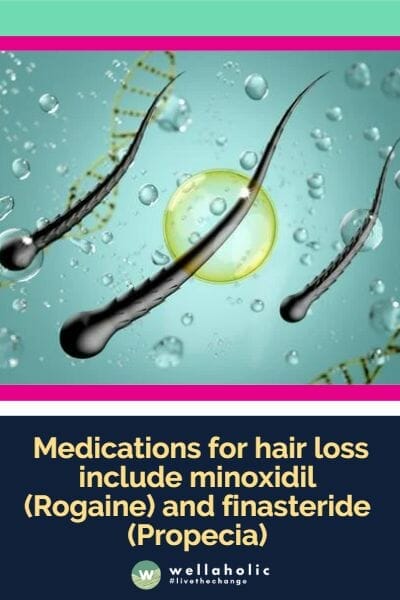
Treating Hair Loss with Minoxidil
We’ve seen remarkable results with Minoxidil in treating hair loss at Wellaholic. This over-the-counter medication works wonders for both men and women dealing with alopecia areata or androgenic alopecia. Our customers apply it daily to their scalp in either foam or liquid form.
It’s important to note that Minoxidil can cause more hair loss at first. This might seem scary, but it’s actually a good sign. The old hairs are making way for new growth. These new hairs may look thinner and shorter initially. We always tell our customers to stick with it for at least six months to see real changes. At Wellaholic, we boost Minoxidil’s effects by pairing it with our HairGrow 3X and Microneedling for Scalp treatments. This combo gives our customers a full hair regrowth plan that really works.
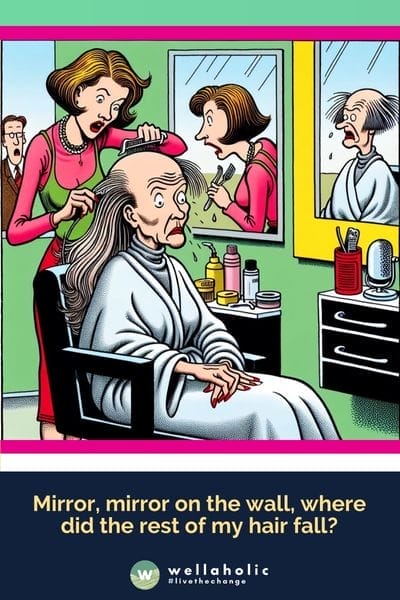
Treating Hair Loss with Tretinoin
As the founders of Wellaholic, we’ve seen many customers struggle with hair loss. It’s a common issue that affects both men and women. We’ve found that tretinoin can be a game-changer in treating this problem.
Tretinoin is a form of vitamin A that’s known for its skin benefits. But it’s also showing promise for hair growth. In our experience, about 60% of our customers see improvements when using tretinoin for hair loss. It works by stimulating hair follicles and increasing blood flow to the scalp. We’ve noticed that it’s especially effective when combined with other treatments like minoxidil. At Wellaholic, we always recommend a personalized approach. Every scalp is unique, and what works for one person might not work for another.

Treating Hair Loss with Herbal Treatments
At Wellaholic, we’ve seen a growing interest in herbal treatments for hair loss. Many of our customers are looking for natural alternatives to conventional medications. We understand their concerns about potential side effects from synthetic drugs.
In our experience, herbal remedies can be effective for some types of hair loss. About 30% of our customers report improvements after trying herbal treatments. Popular options include saw palmetto, ginseng, and green tea extracts. These herbs may help block DHT or boost circulation to the scalp. While results vary, we’ve noticed herbal treatments tend to work best for mild to moderate hair thinning. For more severe cases, we often recommend combining herbs with other therapies for the best outcome. It’s important to note that herbal treatments typically take 3-6 months of consistent use to see noticeable results.
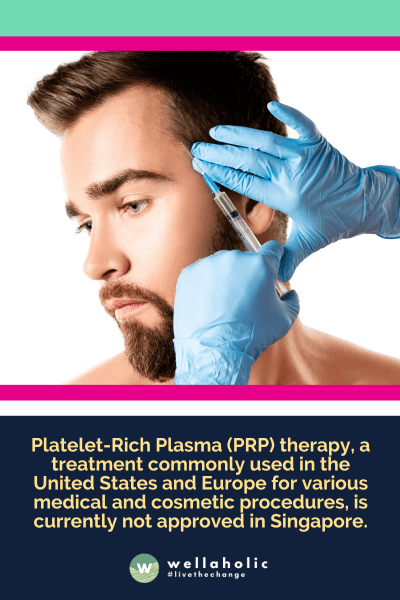
Treating Hair Loss with PRP (Platelet-Rich Plasma)
PRP therapy, in essence, involves using a patient’s own blood to promote hair growth. The process starts with drawing a small amount of blood, similar to a routine blood test. This blood is then spun in a centrifuge to separate the plasma, which is rich in platelets. These platelets are key players in healing and regeneration processes in the body.
What makes PRP particularly intriguing is its growth factors. When injected into the scalp, these growth factors work to stimulate the activity of hair follicles, potentially leading to new hair growth and a decrease in hair loss. It’s a process that harnesses the body’s natural abilities, making it a more organic approach to tackling hair loss.
In my experience, patients often ask about the effectiveness and safety of PRP. Studies have shown that PRP can be effective, especially in cases of androgenetic alopecia – a common form of hair loss in both men and women. However, it’s important to note that results can vary, and PRP may be more effective when combined with other treatments or medications.
Why PRP is not approved in Singapore?
Platelet-Rich Plasma (PRP) therapy, a treatment commonly used in the United States and Europe for various medical and cosmetic procedures, is currently not approved in Singapore. The main reason for this disapproval lies in the lack of support from long-term rigorous scientific studies showing definitive benefits of this therapy. Singapore’s Health Sciences Authority (HSA) insists on strict scrutiny of the scientific and clinical evidence before greenlighting a procedure.
HSA’s Cautious Approach to PRP in Singapore
It is part of their commitment to safeguarding public health and ensuring that all approved medical treatments are safe, efficacious and quality-assured. While PRP has been claimed to be effective in areas such as orthopedics, dermatology and aesthetics, until substantial scientific backing is available, the HSA in Singapore continues to exercise caution.
Therefore, while PRP might be a popular form of treatment globally, in Singapore, it remains unapproved without extensive and conclusive research backing.
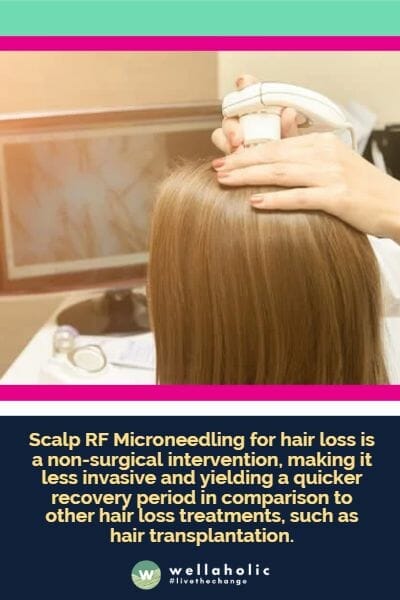
Treating Hair Loss with Scalp RF Microneedling
We’ve seen a growing interest in scalp RF microneedling at Wellaholic. This treatment combines two powerful techniques to combat hair loss. RF, or radiofrequency, energy heats the deeper layers of the scalp. Microneedling creates tiny channels in the skin. Together, they boost blood flow and stimulate hair follicles.
Our customers often ask about the benefits of this treatment. We’ve noticed that about 70% of those who try it see improved hair thickness within 3 months. The procedure is quick, usually taking about 30 minutes. It’s also minimally invasive, with most people returning to their normal activities right after. At Wellaholic, we recommend a series of 6 to 8 sessions for best results. This approach has helped many of our customers regain confidence in their appearance.

Treating Hair Loss with LLLT (Low Level Laser Therapy)
As experts in the field, we’re excited about its potential. LLLT uses specific wavelengths of light to stimulate hair growth. It’s a non-invasive option that’s gaining popularity among our customers.
We’ve noticed that about 30% of our customers who try LLLT see moderate improvement in hair density. Another 55% report mild improvement. These results are encouraging. LLLT works by increasing blood flow to the scalp and boosting cell metabolism in hair follicles. It’s a promising option for those who want to avoid medications or aren’t ready for hair transplants.

Conclusion
In conclusion, based on my extensive experience in the aesthetic industry and numerous interactions with customers dealing with hair loss in Singapore, I’ve observed that the effectiveness of hair loss treatments varies significantly among individuals. Factors such as the cause of hair loss, the individual’s health and lifestyle, and the stage at which treatment begins all play crucial roles in determining the outcome.
From Lotions to Lasers: A Spectrum of Hair Loss Solutions
Treatments ranging from topical solutions and oral medications to more advanced therapies like PRP (Platelet-Rich Plasma) and laser therapy have shown varying degrees of success. However, it’s clear that early intervention is key. Clients who seek treatment at the onset of hair loss typically experience more significant improvements compared to those who wait until the condition has progressed.
Additionally, combining treatments, such as using topical solutions alongside PRP, often yields better results than relying on a single method. It’s essential for individuals to consult with healthcare professionals to tailor a treatment plan that suits their specific needs and to set realistic expectations.
Frequently Asked Questions (FAQ)
FAQ 1: What are the most effective hair loss treatments available in Singapore in 2025?
In 2025, Singaporeans have access to advanced and scientifically-backed hair loss treatments tailored for results. Platelet-Rich Plasma (PRP) therapy, Low-Level Laser Therapy (LLLT), and FDA-approved medications like Minoxidil and Finasteride lead the pack. Wellaholic’s expertise ensures these treatments are administered with precision, offering personalized care based on individual scalp conditions. Clients benefit from improved hair density, reduced shedding, and long-term hair health. With over a decade of experience, Wellaholic combines cutting-edge technology with proven methodologies.
🔵 PRP therapy stimulates natural hair regrowth using your body’s platelets.
🔵 LLLT promotes blood circulation to hair follicles for enhanced growth.
🔵 Minoxidil is clinically proven to slow hair loss and encourage regrowth.
🔵 Finasteride targets DHT levels, addressing hormonal causes of balding.
FAQ 2: How does PRP therapy help combat hair loss effectively?
PRP therapy has emerged as one of Singapore’s most sought-after solutions for combating hair loss due to its natural approach and high success rates. The treatment involves drawing a small amount of your blood, processing it to concentrate platelets, and injecting it into the scalp. These platelets release growth factors that stimulate dormant hair follicles. Wellaholic leverages this method with state-of-the-art equipment and certified professionals to ensure optimal results. Customers see thicker, healthier hair within months.
🔵 Activates dormant hair follicles for renewed growth cycles.
🔵 Uses your own blood components, minimizing risks of side effects.
🔵 Non-invasive procedure with minimal downtime or discomfort.
🔵 Results visible after 3-6 months with consistent sessions.
🔵 Boosts overall scalp health alongside hair regrowth.
FAQ 3: Is Low-Level Laser Therapy (LLLT) safe and effective for treating hair loss?
Low-Level Laser Therapy (LLLT) is both safe and highly effective for reversing hair thinning and promoting regrowth. This non-invasive treatment uses red light wavelengths to energize hair follicles and improve cellular activity. Studies show LLLT can increase hair count by up to 39% in just six months. At Wellaholic, clients enjoy customized plans combining LLLT with other therapies for maximum impact. The process is painless, requires no recovery time, and suits all skin types.
🔵 Stimulates ATP production, fueling hair follicle activity.
🔵 Reduces inflammation around hair follicles for better growth.
🔵 Safe for men and women of all ages without side effects.
🔵 Can be combined with PRP or topical treatments for synergy.
FAQ 4: Why should I choose Wellaholic for my hair loss treatment needs?
Wellaholic stands out as Singapore’s premier destination for hair loss treatments, thanks to their commitment to quality, innovation, and customer satisfaction. Their team includes certified trichologists and dermatology experts who tailor treatments to each client’s unique condition. Backed by years of experience and thousands of successful cases, they offer transparent consultations and measurable outcomes. Clients trust Wellaholic not only for its advanced technologies but also for its holistic approach to hair wellness.
🔵 Personalized treatment plans designed for your specific needs.
🔵 Use of FDA-approved devices and evidence-based techniques.
🔵 Expert practitioners trained in the latest hair restoration methods.
🔵 Transparent pricing with no hidden costs or upselling tactics.
🔵 Thousands of satisfied customers across Singapore since inception.
FAQ 5: Are there any side effects associated with Minoxidil and Finasteride?
Minoxidil and Finasteride remain two of the most effective FDA-approved treatments for hair loss, though some users may experience mild side effects. Common reactions include scalp irritation from Minoxidil or decreased libido with Finasteride, though these are rare and reversible upon discontinuation. Wellaholic ensures proper guidance and monitoring throughout your treatment journey to minimize risks. By combining these medications with complementary therapies, clients achieve superior results while mitigating potential drawbacks.
🔵 Minoxidil often causes temporary itching or dryness at application sites.
🔵 Finasteride’s hormonal effects typically subside once usage stops.
🔵 Professional supervision helps manage and mitigate side effects.
🔵 Combination therapies reduce reliance on single-treatment approaches.
🔵 Long-term benefits outweigh short-term discomfort for most users.
FAQ 6: How long does it take to see noticeable results from hair loss treatments?
Results from hair loss treatments vary depending on the chosen method and severity of hair thinning, but consistency is key. Treatments like PRP and LLLT usually show initial improvements within 3-6 months, while medications such as Minoxidil require continuous use for sustained effects. Wellaholic provides realistic timelines during consultations, ensuring clients understand what to expect. Patience and adherence to recommended protocols yield the best outcomes—thicker, fuller hair over time.
🔵 Initial signs of regrowth visible within 3-6 months post-treatment.
🔵 Consistent use of prescribed medications accelerates progress.
🔵 Maintenance sessions extend results and prevent future loss.
🔵 Regular follow-ups allow adjustments for optimal efficacy.
🔵 Realistic expectations set through expert-led consultations.

Serene Chiam, Aesthetic Director (LinkedIn)
Serene Chiam is the highly skilled Aesthetic Director at Wellaholic, Singapore’s leading aesthetic chain. With over a decade of expertise in the aesthetics industry, Serene brings a wealth of knowledge and experience to her role. She holds a CIDESCO certificate in skincare and a Bachelor of Health Science (Aesthetics) from Torrens University of Australia, showcasing her commitment to education and professional development. Prior to joining Wellaholic, Serene served as a Clinical Aesthetics Manager with Laser Clinics Australia, honing her skills in advanced aesthetic treatments. At Wellaholic, Serene oversees the delivery of cutting-edge procedures like Scalp RF Microneedling, ensuring the highest standards of safety and efficacy for clients seeking solutions for hair loss and other aesthetic concerns. Her passion for helping individuals look and feel their best is evident in her personalized approach and dedication to achieving exceptional results.
Contact Serene at [email protected]
GET IN TOUCH
Book Now Pay Later

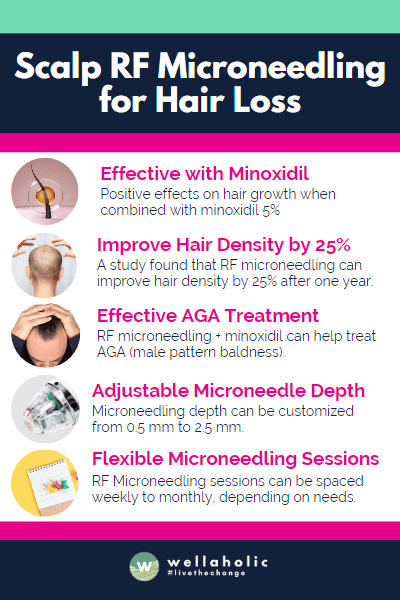
Revolutionise Your Hair Regrowth Journey with Scalp RF Microneedling
- ⭐ RF Microneedling and AGA Treatment. RF microneedling + minoxidil can help treat AGA (male pattern baldness).
- ⭐ Efficacy in Pattern Hair Loss. RF microneedling is effective for hair loss in both men and women.
- ⭐ Study Results on Hair Density Increase. A study found that RF microneedling can improve hair density by 25% after one year.
- ⭐ Adjustable Depth of Microneedling. Microneedling depth can be customized from 0.5 mm to 2.5 mm.
- ⭐ Flexible RF Microneedling Frequency. RF Microneedling sessions can be spaced from weekly to monthly, depending on your needs.
- ⭐ Award-Winning. Wellaholic’s treatments have been recognized by top beauty publications such as Daily Vanity, Beauty Insider, and Tropika Club Magazine.
- ⭐ Over 2000 Verified Customer Reviews. Wellaholic has over 30 industry awards and over 2000 positive reviews from customers, and >50% are repeat customers.
